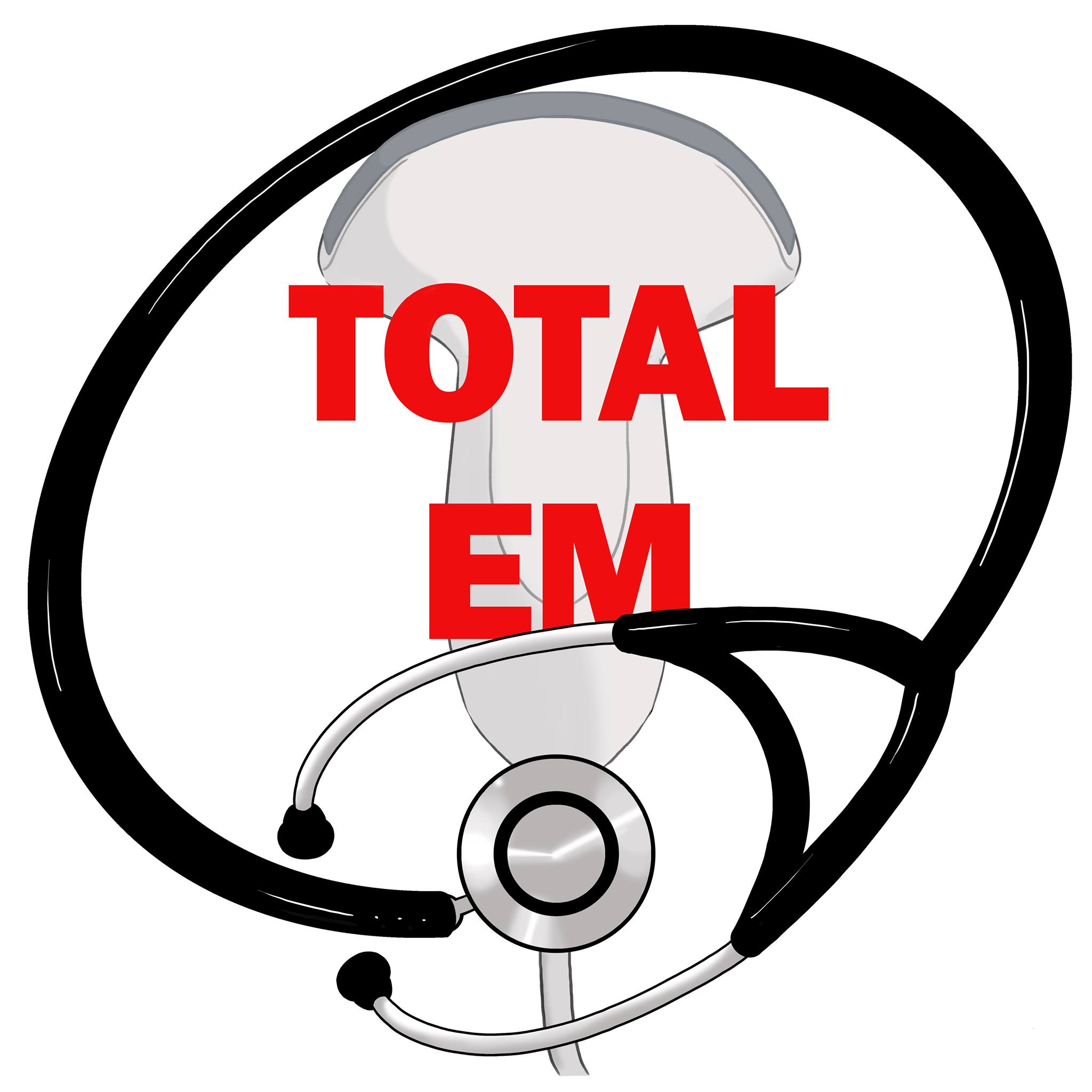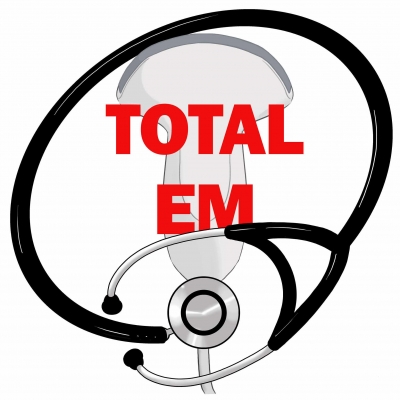Discover TOTAL EM - Tools Of the Trade and Academic Learning in Emergency Medicine
TOTAL EM - Tools Of the Trade and Academic Learning in Emergency Medicine

TOTAL EM - Tools Of the Trade and Academic Learning in Emergency Medicine
Author: Chip Lange
Subscribed: 711Played: 11,367Subscribe
Share
© TOTAL EM Copyright 2016
Description
We are a FOAMED project devoted to providing TOTAL care everywhere. This is done by sharing the Tools Of the Trade and Academic Learning in Emergency Medicine (TOTAL EM). We believe in education for emergency medicine professionals and the public.
244 Episodes
Reverse
There are a variety of anorectal emergencies that present to the emergency department. Recently, there were updated guidelines made by the World Society of Emergency Surgery (WSES) and the American Association for the Surgery of Trauma (AAST). In this post, we review some of the updated guidelines including for anorectal abscess, perineal necrotizing fasciitis (Fournier's gangrene), bleeding anorectal varices, complicated rectal prolapse (irreducible or strangulated), and retained anorectal foreign bodies.
We are back to providing our ATLS content and we are picking up where we left off. Our last ATLS podcast was on spine and spinal cord trauma. Somewhat similar in nature is musculoskeletal trauma. This is a very common form of trauma. However, delayed recognition and treatment can result in life-threatening hemorrhage or limb loss.
Cluster headaches are often considered one of the most painful human experiences. They are short (lasting usually 15-180 minutes), frequent (up to 8 a day), unilateral headaches behind or around the eye often with ipsilateral autonomic symptoms and restlessness. While migraines and tension headaches are seen frequently in the emergency department, cluster headaches are much less frequently seen and often are harder to identify as a result. There are certain points to remember with patients that are experiencing cluster headaches and we list 10 of them here.
The use of tranexamic acid (TXA) has expanded with growing evidence in its use for a variety of clinical situations. However, not all evidence is created equal and not all applications show benefit. In this blog and podcast we discuss the various uses of TXA and the surrounding evidence.
For decades, there has been a major name debate regarding the appropriate title for PAs. However, on May 24, 2021 the American Academy of PAs (AAPA) House of Delegates (HOD) came to a vote. Over 100 possible titles were considered, but ultimately the winning vote was for "physician associate" which has led to a significant amount of discussion. What is the history behind this decision and why now? What has been the response? We discuss this and more in this new blog and podcast.
There are countless guides and references that can be used in emergency medicine. However, some books prove to be better resources than others and it is vital to identify them. In this post, we review one of the books you should seriously consider having if you work in emergency medicine.
Last year, the American Heart Association (AHA) provided updates to their basic life support (BLS), advanced cardiac life support (ACLS), and pediatric advanced life support (PALS) programs. Mike Sharma is helping again by reviewing some of the key updates and changes to guidelines. We also provide some additional feedback and information to consider with these new guidelines.
March is Women's History Month and we wanted to celebrate some of the accomplishments of women in medicine. While there are countless women that could be mentioned, we wanted to focus on a few that have been seen as pioneers in medicine.
Recently there was commentary in a forum that suggested the Pulmonary Embolism Rule-Out Criteria (PERC Rule) was essentially useless for detecting a pulmonary embolism (PE). It started with an anecdote, which is a logical fallacy (post hoc ergo propter hoc) and went wild from there. This led to the realization that many still do not understand how to use the Wells' Criteria for Pulmonary Embolism (referred to from here simply as the Wells' Criteria) and the PERC Rule.
Injuries to the spine can occur both in blunt and penetrating trauma. They can also be with or without neurological deficits. For this reason, they should be considered in all patients with multiple injuries. In this podcast, Chip Lange and Mike Sharma review the pearls and pitfalls of this disease process.
We are able to provide a sneak peak at some updated content with Practical POCUS. Over the last few months, Practical POCUS has been working to improve its content with the plan to help further promote point of care ultrasound (POCUS) to a broader audience. One audience in particular is with EMS. This 10 minute video is an excerpt from the updated course worth 24 hours of CME. Make sure to check out PracticalPOCUS.com to learn more.
A little while back, we asked for help on getting out more content. David Wright and Kate Randolph answered that call and provided a special podcast on osteogenesis imperfecta. We hope you enjoy this unique podcast and encourage you to reach out if you want to contribute, as well.
Neonatal sepsis can be subtle, especially early on. It can rapidly progress to multisystem organ failure, meningitis, and death. Given the real dangers of neonatal sepsis, we will focus on 10 key points to remember when evaluating for this lurking terror.
Elevated intracranial pressure (ICP) was just discussed in our last podcast on head injuries. However, we briefly mentioned how there is a certain amount of controversy on this subject. This separate podcast is to act as a supplement to the Chapter 6 ATLS podcast on head trauma that was just covered. We find this particularly important given how long our ATLS podcasts run in general.
The newest Advanced Trauma Life Support (ATLS) blog and podcast is here! This time we talk about head trauma. Get the key pearls and pitfalls as provided by Chip Lange and Mike Sharma.
We received quite a bit of feedback with the last podcast and requests to discuss specifically the variants and their potential impacts on the current COVID-19 vaccines. It is worth noting that at the time of this publication there is still limited data but we discuss the key concepts and takeaways with the current knowledge we have on the topic.
There have already been many podcasts discussing COVID-19 vaccines, so what makes this one different and worth listening to now? This podcast is more about some of the key highlights and frequent questions asked to help listeners get the right resources and information.
We are back at it again with our newest ATLS podcast. This time we are focusing on the abdomen and pelvis which can be host to a wide range of severe pathology. Given its many intricacies, we focused most on the highlights from ATLS Chapter 5 including the key "red text" that it emphasizes.
Recently, the Centers for Disease Control (CDC) released updated guidelines for treating gonococcal infections. Given the increase in antibiotic resistance, this provides an important change in the recommended management for not only gonorrhea but also chlamydia.
2020 was a very different year and now it is time to start into 2021. As always this time of year we want to provide everyone with an update and our plans. This is especially true given how the last couple of months have been particularly challenging with COVID-19.






















